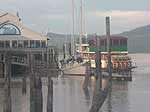 |
Published 04/22/09
Killer Whales Hitting Central Oregon Coast Waters for Baby Whales
 |
| An Orca cruises around Depoe Bay's waters. (Photo: Morris Grover, with the Whale Watch Center) |
(Depoe Bay, Oregon) – It's Killer Whale season again on the Oregon coast, and they have started showing up. Orcas begin to hunt on the central Oregon coast about April 15 – and as if right on schedule – they were spotted last week, on April 16.
Morris Grover, with the Whale Watch Center in Depoe Bay, said seven were spotted on that day – a slightly larger number than usual. They typically linger for about a month, until around May 15.
Killer whales hit the area in search of baby gray whales, or perhaps maybe a few sea lions or seals to munch on. They know the grays are migrating, with mothers dragging recently born calves along. Well aware they can’t take out full-grown whales, their hunting centers on the smaller baby whales. Often, their technique involves some distracting the mother, while others take out the little one.
 |
| The Orcas have been known to chase seals into Newport's Yaquina Bay. |
Officials at the Whale Watch Center have seen them gobble up seals and sea lions in the waters of Depoe Bay.
They are rarely seen in these waters, except at this time of year. When it does happen, it's in the Depoe Bay and Newport areas, but they may be seen from Cascade Head all the way down to Florence and farther.
They are seen more often on the central coast because there are more officials that spend more time watching for them.
The killer whales are what are known as "transient" whales, meaning officials don't know where they come from. They're also more predatory, living off seals and baby gray whales.
 |
| Seaside Aquarium's Tiffany Boothe caught these Orca photos near Florence and the Sea Lion Caves in 2006. |
Grover said these are smaller and more shark-like in appearance than what are nicknamed the "friendly" killer whales, which visit here from the San Juan Islands and live on salmon.
Grover said the public's ability to spot Orcas or even gray whales is largely dependent on oceanic conditions, which haven't always been prime so far in April. "We know they're out there," he said. "But looking for whales blow on a day like today, with a lot of white caps, it's like camouflage for whales."
March viewing conditions were excellent. While April has had a few good days, they weren’t as numerous.
 |
| Photo Seaside Aquarium's Tiffany Boothe |
To catch sight of these killer whales, just like spotting any whale, Grover suggests patience, and head to a high vantage point. The Newport area has many of these, such as the lighthouse at Yaquina Head, Devils Punch Bowl and nearby at Cape Foulweather. The headquarters for the Whale Watch Spoken Here program is in Depoe Bay, at the seawall, and is another good spot for seeing them as well.
Other suggestions for whale spotting:
- Don't go to the beach. Go to a higher vantage point, at least 50 feet above sea level.
- Look for a day with a flat ocean - waves don't hide the whales from view.
- Newport and Depoe Bay have many whale watching tours, which may help increase sightings.
 |
| Photo Seaside Aquarium's Tiffany Boothe |
Killer whales usually show up in this area in small pods of three to five, sometimes as many as nine. Grover said these transient whales don't seem to form large families, such as Orcas in the Puget Sound.
Grover said they can sometimes be seen coming into Yaquina Bay in Newport when they can't find baby whales, attracted by the proliferation of seals and sea lions in the bay. Some years, they have also been known to linger at the edges of the bay's jetties. There have been a few sightings in recent years was of killer whales chasing a seal all the way through Yaquina Bay, almost as far east as Toledo.
"It's all food related," Grover said. "They come up here all the time. Basically, they will take the easiest prey."
 |
| Cape Foulweather is a good spot to see any kind of whale, should conditions be condusive. |
Grover said they are sometimes seen apparently “playing” with their food by tossing it back and forth, or slapping it with their tails. This unique behavior has to do with teaching their young how to hunt.
In 2006, the killer whales lingered until the middle of July.
“That is a very long time for them, but it was obviously supported by local food for them,” Grover said. “We watched a pod of five around Depoe Bay and actually filmed them taking what we believed to be a seal in the south end of the bay. Seals and sea lions are fast in the water and Orcas have to burn up a lot of energy to catch them. After all that work, only one seal will feed one Orca. When they kill a baby gray whale, the whole pod can eat for a week.”
For more about Newport....
 |
 |
 |
RELATED STORIES
Unusual Travel Articles TravelParanormal.com allows you to submit your own creepy tale or debunk one - or see up-to-the-minute news headlines about travel and the paranormal.
Watching Transformations of Oregon Coast Beaches Seasons change and so do beaches, revealing different sides and a variety of eye-popping sights
Staggeringly Cool Ideas for Oregon Coast Romance Be it the season of Valentine's or be it any time of the year, Oregon's coastline has essentially cornered the market for cuddle-inducing possibilities and gushy activities for the hand-holding set
Day or Night Mysteries and Merriment on Oregon Coast It's more than just nightlife that comes to life, but the beaches offer major opportunities
News Headlines from All Over Oregon Need to scan Oregon headlines? Constantly updated news from all over Oregon: a comprehensive, up-to-the-minute display of news headlines from a variety of media.
Secrets of the Season |





































